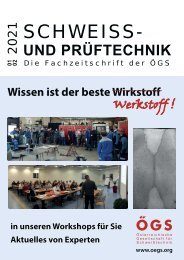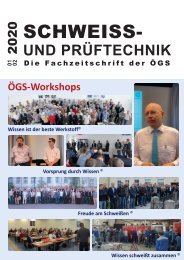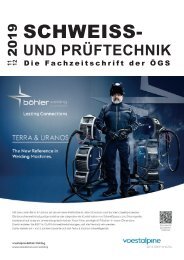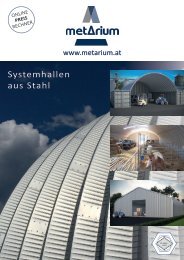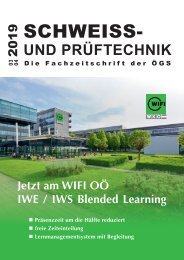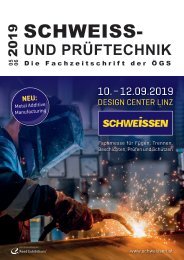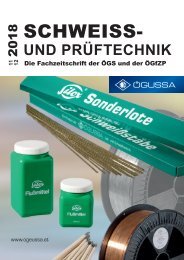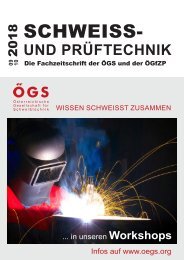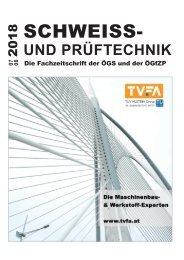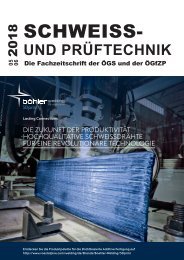Fachzeitschrift_OeGS_09_10_2019
Sie wollen auch ein ePaper? Erhöhen Sie die Reichweite Ihrer Titel.
YUMPU macht aus Druck-PDFs automatisch weboptimierte ePaper, die Google liebt.
Abstracts aus „Welding in the World“ No. 4/<strong>2019</strong><br />
mit freundlicher Genehmigung des IIW<br />
Wire-arc additive manufacturing of a duplex stainless<br />
steel: thermal cycle analysis and microstructure<br />
characterization<br />
• V. A. Hosseini, M. Högström, K. Hurtig, M. Asuncion,<br />
V. Bermejo, L.-E. Stridh, L. Karlsson<br />
The evolution of microstructures with thermal cycles was<br />
studied for wire-arc additive manufacturing of duplex stainless<br />
steel blocks. To produce samples, arc energy of 0.5 kJ/<br />
mm and interlayer temperature of 150 °C were used as low<br />
heat input–low interlayer temperature (LHLT) and arc energy<br />
of 0.8 kJ/mm and interlayer temperature of 250 °C as<br />
high heat input–high interlayer temperature (HHHT). Thermal<br />
cycles were recorded with different thermocouples<br />
attached to the substrate as well as the built layers. The microstructure<br />
was analyzed using optical and scanning electron<br />
microscopy. The results showed that a similar geometry<br />
was produced with 14 layers—4 beads in each layer—<br />
for LHLT and 15 layers—3 beads in each layer—for HHHT.<br />
Although the number of reheating cycles was higher for<br />
LHLT, each layer was reheated for a shorter time at temperatures<br />
above 600 °C, compared with HHHT. A higher austenite<br />
fraction (+ 8%) was achieved for as-deposited LHLT<br />
beads, which experienced faster cooling between 1200 and<br />
800 °C. The austenite fraction of the bulk of additively<br />
manufactured samples, reheated several times, was quite<br />
similar for LHLT and HHHT samples. A higher fraction of secondary<br />
phases was found in the HHHT sample due to longer<br />
reheating at a high temperature. In conclusion, an<br />
acceptable austenite fraction with a low fraction of<br />
secondary phases was obtained in the bulk of wire-arc<br />
additively manufactured duplex stainless steel samples<br />
(35–60%), where higher austenite fractions formed with a<br />
larger number of reheating cycles as well as longer reheating<br />
at high peak temperatures (800–1200 °C).<br />
Weldability of high-strength aluminium alloy EN<br />
AW-7475-T761 sheets for aerospace applications,<br />
using refill friction stir spot welding<br />
• I. Kwee, W. De Waele, K. Faes<br />
Refill friction stir spot welding is a solid-state welding process<br />
for joining lightweight sheets in the overlap configuration<br />
by means of frictional heat and mechanical work. The<br />
objective is to investigate refill friction stir spot welding of<br />
aluminium alloy EN AW-7475-T761, since fusion welding of<br />
such high-strength alloys is problematic due to solidification<br />
and liquation cracking. This alloy is used in highly<br />
stressed structural parts in aerospace applications, because<br />
of its low weight, superior strength, high corrosion resistance<br />
and corrosion fatigue behaviour. The process parameter<br />
optimization and the effect of the parameters on the<br />
weld characteristics were examined. The dwell time, the<br />
plunge depth and the rotational speed were varied according<br />
to a multi-level factorial design. An increase of the<br />
dwell time resulted in a larger stir zone area and smaller<br />
amount of defects. The width of the central coarse-grained<br />
band became smaller, containing a more refined grain size.<br />
An increase of the rotational speed lead to a smaller stir<br />
zone area, a discontinuous joint line remnant and a larger<br />
width of the central coarse-grained band. An increase of<br />
the plunge depth lead to a larger stir zone area. Welds produced<br />
with a high heat input exhibited a lower average<br />
hardness and a higher hardness drop, compared to welds<br />
with a low high heat input. Analysis of variance has shown<br />
that the dwell time, the plunge depth and their interaction<br />
have a statistically significant effect on the lap shear<br />
strength: a longer dwell time, a higher plunge depth and<br />
their interaction resulted into a higher lap shear strength.<br />
Reduced weld strength due to secondary cell formation<br />
in vibration weld region of microcellular glass fiber<br />
reinforced nylon-6 shells<br />
• T. Guo, A. Edrisy, S. H. Eichhorn, J. Vanderveen, B. Baylis,<br />
H. Colwell<br />
Microcellular plastic parts reduce weight and increase<br />
dimensional stability, but a significant decrease in weld<br />
strength is observed when the weld region reaches the cell<br />
area. In this study, 30 wt.% glass fiber reinforced nylon-6<br />
shells with weight reductions of 0%, 7%, and <strong>10</strong>% were<br />
fabricated by microcellular injection molding with nitrogen<br />
gas followed by vibration welding. Although the weld depth<br />
of the vibration weld was much less than the thickness of<br />
the cell-free surface layer, microstructural analysis of fracture<br />
surfaces by scanning electron microscopy and optical<br />
microscopy confirmed the presence of cells at the weld<br />
region that lowered burst pressures by 17% and 22% for<br />
shells with weight reductions of 7% and <strong>10</strong>%, respectively,<br />
when compared with the burst pressure of 1.16 MPa for<br />
solid shells. The irregular sizes and elongated shapes of these<br />
cells suggest that they were generated in the molten polymer<br />
by secondary nucleation of residual nitrogen gas<br />
during the vibration welding process. This assumption is<br />
corroborated by the fact that no cells are formed in the<br />
weld area of solid shells with 0% weight reduction and is<br />
consistent with recently reported similar findings for glass<br />
fiber reinforced polypropylene.<br />
SCHWEISS- UND PRÜFTECHNIK <strong>09</strong>-<strong>10</strong>/<strong>2019</strong> 187




